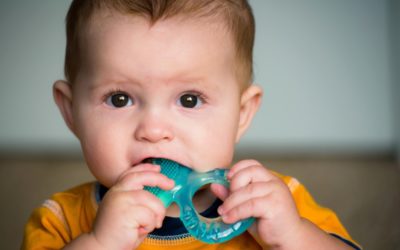Most babies have at least one diaper rash before they are toilet trained. It is the most common type of rash in babies! The majority of baby diaper rash we see is caused by irritation of the sensitive skin that comes in contact with urine and stool. Yeast infections are also prevalent. Bacterial infections of the diaper area are far less common.
Diaper Rash Causes
The primary cause of diaper rash is prolonged and increased exposure to wetness/moisture against the skin.
Diapers are usually snug-fitting, so there’s little to no air circulation. This causes the baby’s bottom to collect extra moisture that irritates your baby’s skin, causing a rash.
Contact Dermatitis
Most newborn diaper rash is caused by contact dermatitis. When pee and poo come in contact with the baby’s skin, it can become irritated and inflamed.
The skin of a baby is susceptible! This diaper rash will be red where the skin touches the diaper, sparing the skin in the creases that do not contact pee and poo. Sometimes it will become deep, with painful ulcers that bleed.
What is the Best Diaper Rash Treatment?
For uncomplicated or mild contact dermatitis on the baby’s skin, I suggest applying thick layers of zinc oxide cream. I describe this as applying icing on a cake. Thick! Use the highest percentage of zinc you can find. This helps to prevent diaper rash as well.
When baby poos, gently wipe away the stool and apply more cream. The goal is to avoid seeing the red, irritated skin as it should be generously coated.
Diaper or baby wipes often have alcohol in them and can be irritating to the skin. If your baby has a rash, consider wiping gently with water and face cloth or tissue to clean the diaper area instead of cleaning with a diaper wipe.
I do not recommend using cornstarch for diaper rash on the baby’s skin, which can lead to yeast growth or thrush infections. In addition, I do not recommend using baby powder on diaper rashes, as this can be inhaled into the baby’s lungs. This can be dangerous and cause breathing difficulty.
Consider letting the area air dry with the baby’s diaper removed. Allowing the diaper area to air dry with less moisture can work wonders.
Yeast Diaper Rash
Candida or yeast lives all over our skin. When the skin breaks down, as with contact dermatitis, yeast can enter the broken skin and cause infection. Yeast loves warm, moist areas, which is the case with this baby diaper rash. Recent antibiotic use can also increase the risk for yeast infection.
Yeast on the skin typically looks like red dots around an area of redness or inflamed skin. We call these satellite lesions. Yeast usually grows in skin creases. You may notice that this rash is not responding to treatment for contact dermatitis with zinc alone.
See your healthcare provider if you think your child has a yeast infection, as medication can help.
We treat yeast infections with zinc, contact dermatitis to dry out the area, and add cream for baby’s diaper rash with topical antifungal medication, such as Cotrimoxazole. Sometimes we add in a topical steroid to decrease the pain and inflammation caused by the rash.
Seborrheic Dermatitis
Some children will develop a cradle cap-type rash or seborrheic dermatitis. This looks like yellow, greasy scales in the diaper area that may affect the scalp and face.
Petroleum or petroleum-free jelly may alleviate this rash. Your doctor may also prescribe a low-dose steroid cream.
Bacterial Infection
Our skin has bacteria on it, even when we are healthy. When there is a break in the skin, such as contact dermatitis, bacteria that live on the skin can grow on this broken skin, leading to bacterial infections.
Bacterial diaper rashes look like pimple-like lesions with overlying redness and sometimes blisters. We often describe this as ‘beefy red.’ It is painful. If you suspect a bacterial infection, please see your doctor.
If your baby has a bacterial diaper rash, a topical or oral antibiotic may be necessary.
What can you do for diaper rash?
The best method to avoid diaper rashes is to change your baby’s diaper regularly. This is especially true when they are often pooing or having the same diaper on for long periods, like at night. Applying petroleum or non-petroleum jelly or zinc oxide baby diaper rash cream acts as a barrier preventing the skin from direct contact with poo and pee.
Allowing for some diaper-free time can enable the skin to dry and help treat and avoid irritation. In addition, some research demonstrates that babies who wear cloth diapers, which are less absorbent than disposable diapers, are more likely to battle diaper rashes.
Cloth diaper-wearing babies may avoid rashes by wearing disposable diapers, mainly when sleeping for long periods if they are getting recurrent rashes. If your baby has a persistent or worsening diaper rash, please see your doctor to ensure no infection requires treatment.
FAQ’S
What causes diaper rash?
Diaper rash is a condition that can be caused by wearing wet or infrequently changed diapers, sensitive skin, and chafing.
What is the best way to keep your baby’s skin safe and prevent diaper rash?
Wash your hands before and after every change, change as soon as the area is wet or soiled, use mild wipes, and use rash cream.
Is treating diaper rash difficult?
Not all diaper rashes are created equal. Some heal in a matter of days, but others can take weeks to go away.










